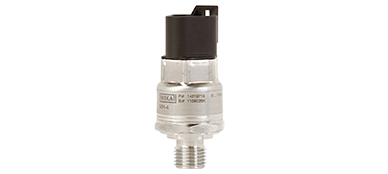
Due to their diverse scope of tasks, OEMs have a wide range of requirements and needs for their applications. Manufacturers of mobile working machines have a particular expectation of the properties that a pressure sensor should possess. WIKA has been guided by this in the development of the MH-4, the latest version of their OEM pressure sensor for mobile working machines.
Over two decades ago, WIKA introduced the MH-1 pressure sensor for mobile working machines. OEMs have appreciated this robust pressure sensor for its precision and durability under harsh conditions. Since that time, our industrial instrumentation experts have developed future generations of this sensor in close cooperation with those who rely on its reliable performance the most: the customers.
From problem to solution: The pressure sensor MH-2
Several years ago, a major global manufacturer of agricultural machinery replaced their hydraulic pumps to increase their vehicles’ efficiency. However, this led to regular failures of the pressure sensors. In order to minimise such downtimes, whenever a machine was repaired, the on-site technicians, thus, always opted to replace all the sensors too. However, an inspection of the sensors returned through the supplier showed that half of them were still fully functional. In such cases, where no fault was found (NFF), the manufacturer incurred unnecessary costs − in the millions.
As for the sensors that were damaged, extreme pressure spikes were found as the culprit. The OEM conducted a series of tests, but couldn’t see any pressure spikes in their hydraulic system. As a result, the supplier was then asked for help. However, the supplier basically refused this request, since they did not see their sensors as the cause of the problem. Frustrated with their supplier’s unwillingness to collaborate on a solution, the manufacturer reached out to WIKA. Our experts found two issues after extensive testing:
- The new hydraulic pumps generated high pressure ripples in the hydraulic system
- Certain sensing elements were more susceptible to failure from fast-moving pressure ripples than other types
Additional lab and field tests showed that WIKA’s MH-2, a pressure sensor with a cavitation damping system (CDS) and welded thin-film sensing technology, was ideally suited to withstand high-amplitude, short-duration pressure ripples. The manufacturer was convinced by this solution and installed the MH-2 in their agricultural machinery as OEM replacement sensors.
Development of a pressure sensor for mobile working machines: From MH-2 to MH-3
A further concern of the agricultural machinery manufacturer was minimising the number of future NFF complaints. A team of experts from WIKA took on this problem and worked diligently to develop a prototype with integrated diagnostic functions, which would enable simple fault detection on-site. This was the starting point for the creation of the MH-3 pressure sensor.

MH-4: OEM-Drucksensor für mobile Arbeitsmaschinen
A robust and easily integrated pressure sensor: The MH-4
The machinery manufacturer appreciated the MH-3’s performance, durability, and onboard diagnostics, as did other large OEMs. Since WIKA attaches great importance to feedback from customers and users, their needs and requirements were further taken into account in its subsequent development:
- Compact design to better fit in today’s modern machinery
- An all-welded stainless steel body to better withstand mobile working machines’ demanding working environments
- Unique two-wrench system suitable for socket wrenches to allow for integration into series production environments
- A large selection of configurations for easy integration into any machine platform and manufacturing process
- Low signal noise for improved output signal quality and stability.
- “Total error band” (TEB) of ±1% full scale over a wide temperature range that takes into account the thermal effects of mobile working machines.
The state-of-the-art MH-4 is a powerful, ultra-robust pressure sensor with excellent long-term stability, making it ideal for use in extreme environments. With a variety of process- and electrical-connection types, the MH-4 is easily integrated into almost any machine platform and manufacturing process. The sensors are manufactured on a fully automated production line so that even very large orders can be fulfilled with short turnaround and delivery times.
Note
Further information on model MH-4 or mobile working machines can also be found on the WIKA website. In our blog post next week, we will also discuss further advantages and features of the MH-4 and go into more detail about why it is ideal for applications in extreme environments. If you have any questions, your contact will gladly help you.
Also read our post
Pressure Measurement and Diagnostics: WIKA’s Field-Proven Solution
You can also find out more about the MH-4, the OEM pressure sensor for mobile working machines, in the following video:

